Advertisements
Chapters
2: Estimation
3: Numbers in India and International System (With Comparison)
4: Place Value
5: Natural Numbers and Whole Numbers (Including Patterns)
6: Negative Numbers and Integers
7: Number Line
8: HCF and LCM
9: Playing with Numbers
10: Sets
11: Ratio
12: Proportion (Including Word Problems)
13: Unitary Method
14: Fractions
15: Decimal Fractions
16: Percent (Percentage)
17: Idea of Speed, Distance and Time
18: Fundamental Concepts of algebra
19: Fundamental Operations (Related to Algebraic Expressions)
20: Substitution (Including Use of Brackets as Grouping Symbols)
21: Framing Algebraic Expressions (Including Evaluation)
22: Simple (Linear) Equations (Including Word Problems)
23: Fundamental Concepts geometry
24: Angles (With their Types)
25: Properties of Angles and Lines (Including Parallel Lines)
26: Triangles (Including Types, Properties and Constructions)
27: Quadrilateral
28: Polygons
29: The Circle
30: Revision Exercise Symmetry (Including Constructions on Symmetry)
▶ 31: Recognition of Solids
32: Perimeter and Area of Plane Figures
33: Data Handling (Including Pictograph and Bar Graph)
34: Mean and Median
![Selina solutions for Mathematics [English] Class 6 chapter 31 - Recognition of Solids Selina solutions for Mathematics [English] Class 6 chapter 31 - Recognition of Solids - Shaalaa.com](/images/mathematics-english-class-6_6:44f3c4f6e33345f4bf41a86d406bf37f.jpg)
Advertisements
Solutions for Chapter 31: Recognition of Solids
Below listed, you can find solutions for Chapter 31 of CISCE Selina for Mathematics [English] Class 6.
Selina solutions for Mathematics [English] Class 6 31 Recognition of Solids Exercise 31
Identify if the following net can be used to form a cube:

Yes
No
Identify if the following net can be used to form a cube:

Yes
No
Identify if the following net can be used to form a cube:

Yes
No
Identify if the following net can be used to form a cube:

Yes
No
Identify if the following net can be used to form a cube:

Yes
No
Draw at least three different nets for making a cube.
The dimensions of a cuboid are 6 cm, 4 cm and 3 cm. Draw two different types of oblique sketches for this cuboid.
Two cubes, each with 3 cm edge, are placed side by side to form a cuboid. For this cuboid, draw:
(i) an oblique sketch
(ii) an isometric sketch.
The figure, given below, shows shadows of some 3D object when seen under the lamp of an overhead projector:
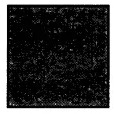
A square
In this case, name the object.
The figure, given below, shows shadows of some 3D object when seen under the lamp of an overhead projector:
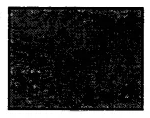
A rectangle
In this case, name the object.
The following figure, given below, shows shadows of some 3D object when seen under the lamp of an overhead projector:

The figure, given below, shows shadows of some 3D object when seen under the lamp of an overhead projector:
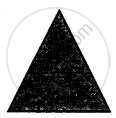
A triangle
In this case, name the object.
Look at the solids, drawn below, and fill the given chart.
(i)

Triangular pyramid
(ii)

Square pyramid
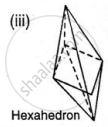
(iv)

Hexagonal
| Polyhedon | Faces(F) | Vertices(V) | Edges(E) | F - E + V |
| (a) Triangular pyramid | ||||
| (b) Square pyramid | ||||
| (c) Hexahedron | ||||
| (d) Hexagonal prism |
Dice are cubes with dots or dots on the face. Opposite faces of a die always have a total of seven on them.
In the given below net to make dice (cube), the numbers inserted in the square indicate the number of dots in it.

Insert suitable numbers in the blank so that numbers in opposite faces of the die have a total of seven dots.
Dice are cubes with dots or dots on the face. Opposite faces of a die always have a total of seven on them.
In the given below net to make dice (cube), the numbers inserted in the square indicate the number of dots in it.

Insert suitable numbers in the blank so that numbers in opposite faces of the die have a total of seven dots.
The following figure represent nets of some solid. Name the solid.

The following figure represent nets of some solid. Name the solid.

The following figure represent the nets of some solid. Name the solid

The following figure represent the nets of some solid. Name the solid
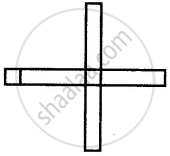
Using Euler’s formula, find the values of a, b, c and d.
| Faces | a | 5 | 20 | 6 |
| Vertices | 6 | b | 12 | d |
| Edges | 12 | 9 | c | 12 |
Using an isometric dot paper, draw: a cube with each edge 3 cm.
Using an isometric dot paper, draw: a cuboid measuring 5 cm x 4 cm x 3 cm.
Solutions for 31: Recognition of Solids
![Selina solutions for Mathematics [English] Class 6 chapter 31 - Recognition of Solids Selina solutions for Mathematics [English] Class 6 chapter 31 - Recognition of Solids - Shaalaa.com](/images/mathematics-english-class-6_6:44f3c4f6e33345f4bf41a86d406bf37f.jpg)
Selina solutions for Mathematics [English] Class 6 chapter 31 - Recognition of Solids
Shaalaa.com has the CISCE Mathematics Mathematics [English] Class 6 CISCE solutions in a manner that help students grasp basic concepts better and faster. The detailed, step-by-step solutions will help you understand the concepts better and clarify any confusion. Selina solutions for Mathematics Mathematics [English] Class 6 CISCE 31 (Recognition of Solids) include all questions with answers and detailed explanations. This will clear students' doubts about questions and improve their application skills while preparing for board exams.
Further, we at Shaalaa.com provide such solutions so students can prepare for written exams. Selina textbook solutions can be a core help for self-study and provide excellent self-help guidance for students.
Concepts covered in Mathematics [English] Class 6 chapter 31 Recognition of Solids are Concept of Recognition of Solids, Identification of 3-d Shapes: Cubes, Cuboids, Cylinder, Sphere, Cone, Prism (Triangular and Square), Pyramid (Triangular and Square), Identification and Locating in the Surroundings., Nets for Building 3-d Shapes, Faces, Edges and Vertices, Faces, Edges and Vertices.
Using Selina Mathematics [English] Class 6 solutions Recognition of Solids exercise by students is an easy way to prepare for the exams, as they involve solutions arranged chapter-wise and also page-wise. The questions involved in Selina Solutions are essential questions that can be asked in the final exam. Maximum CISCE Mathematics [English] Class 6 students prefer Selina Textbook Solutions to score more in exams.
Get the free view of Chapter 31, Recognition of Solids Mathematics [English] Class 6 additional questions for Mathematics Mathematics [English] Class 6 CISCE, and you can use Shaalaa.com to keep it handy for your exam preparation.
